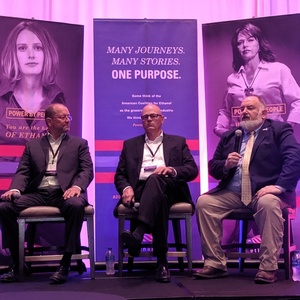Retailers discuss E15, E85 at ACE conference

PHOTO: Matt Thompson
August 16, 2019
BY Matt Thompson
American Coalition for Ethanol Senior Vice President Ron Lamberty moderated a fuel retailer panel at ACE’s annual conference in Omaha, Nebraska Friday. On the panel were Mike Lewis, co-founder of Pearson Fuels and Randy Gard, chief operating officer of Bosselman Enterprises.
Lewis said that Pearson Fuels, a fuel wholesaler has had great success selling E85. Pearson has 163 of 206 E85 locations in California. Being in California, Pearson said he doesn’t sell E15, and he said the blend likely won’t be available in the state soon.
Lewis said, despite not being located close to the Midwest agriculture industry, the decision to sell E85 was a simple one. “It was cheap, and people bought it,” Lewis said.
Advertisement
Annual E85 sales have consistently increased in California. In fact, Pearson sells more E85 than the state of Minnesota, which has the most E85 locations in the U.S. “Pearson Fuels sells about double what the state of Minnesota sells,” Lewis said, eliciting applause from his audience.
Lewis said that despite the increasing demand in California for E85, the number of flex fuel vehicles (FFVs) is a limiting factor. “They are going to go down. It is inevitable,” he said of the manufacture of new FFVs, unless incentives for manufacturing FFVs are restored.
It doesn’t make sense to talk about high-level blends unless FFVs continue to be manufactured, he said, because outside of ethanol advocates, drivers don’t use higher blends in non-flex fuel vehicles. “They need to keep making these flex fuel vehicles,” Lewis said. “If we’ve got a lot of flex fuel vehicles all over the country, we’ve got a lot of ways to go,” he said.
Gard spoke about Bosselman’s experience selling and marketing E15. He said when the company first began to offer the fuel, there wasn’t consistent branding and consumer education about the fuel. “We were doing a huge disservice to our customers,” Gard said. “They simply didn’t know what to do.”
Advertisement
He said as an effort to alleviate confusion among drivers, they launched Boss Fuels, a branding effort. “It’s a simplification of color, of nomenclature, of buttons,” he said. “Our approach is it’s a superior fuel for the road ahead.”
The results were immediate, Gard said, and sales increased. “All we did was brand it and give E15 and give it an identity,” Gard said, adding that E15 has helped the company increase its customer count and average spend at it’s locations.
Related Stories
The U.S. Energy Information Administration maintained its forecast for 2025 and 2026 biodiesel, renewable diesel and sustainable aviation fuel (SAF) production in its latest Short-Term Energy Outlook, released July 8.
XCF Global Inc. on July 10 shared its strategic plan to invest close to $1 billion in developing a network of SAF production facilities, expanding its U.S. footprint, and advancing its international growth strategy.
U.S. fuel ethanol capacity fell slightly in April, while biodiesel and renewable diesel capacity held steady, according to data released by the U.S. EIA on June 30. Feedstock consumption was down when compared to the previous month.
XCF Global Inc. on July 8 provided a production update on its flagship New Rise Reno facility, underscoring that the plant has successfully produced SAF, renewable diesel, and renewable naphtha during its initial ramp-up.
The U.S. exported 31,160.5 metric tons of biodiesel and biodiesel blends of B30 and greater in May, according to data released by the USDA Foreign Agricultural Service on July 3. Biodiesel imports were 2,226.2 metric tons for the month.
Upcoming Events










